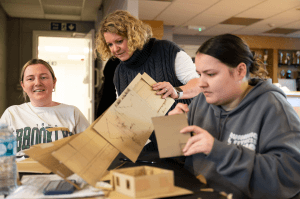
Spotlight on…
Prof Jo Patterson, Principal Investigator and Director, Cardiff University
Can you share a brief overview of your career journey and your current role?
My long career at the Welsh School of Architecture has focussed on applied research associated with sustainable built environments, something I am very passionate about. For the last 15 years my research has involved integrating low carbon technologies into the built environment, particularly housing, where I led a team who designed and built the first affordable energy positive ‘Solcer’ house – the principles of which are now, I’m pleased to say, are being replicated by architects and developers. We’ve also been heavily involved in the deep retrofit of more than 40 homes where a combination of energy demand reduction, energy supply and energy storage technologies have been integrated, the learnings and methods developed have been applied by many other organisations. We’ve modelled and monitored the homes pre and post retrofit to gather important evidence including energy use, temperatures and humidity and how the systems work. We also fully engaged with all stakeholders throughout the whole process to really understand where the opportunities and challenges are, learning and sharing lessons over time. Our work even helped to inspire the establishment of the Optimised Retrofit Programme in Wales which, since its launch in 2020, has seen 27,000 homes retrofitted with over £260million invested.
Following Prof Pete Walker’s recent retirement, I will now be taking on the role of Director of the Transforming Homes project. It will be an absolute privilege to continue to work with our multi-disciplinary team to push ‘beyond retrofit’, focussing on 1920-1940 homes, improving design/space of housing, using bio-based materials to reduce energy demand instead of more traditional fossil-based materials, and providing renewable energy supply and storage technologies.
Yes, it’s extremely important to reduce carbon emissions through reducing energy demand and using renewables through retrofitting, however, with an aging housing stock we really have to be transforming our homes to be fully fit for the future. The way we live, and what we use in our everyday lives has changed significantly over the last 100 years – we need to ensure that our homes provide us with comfortable, healthy, affordable and enjoyable places in which to spend our time for many decades to come.
What has been most rewarding about contributing to the Transforming Homes project?
It’s clear to me that everyone in the transforming homes consortium really wants to make a difference to people lives, and as a result of this, we’re really communicating and collaborating very successfully. Working together across disciplines is delivering methods and evidence that will provide residents, industry, governments and communities with information that will help them make positive changes.
Our whole day charettes with residents in 1920-1940 housing estates across the UK is a great example of this. Everyone who took part really enjoyed themselves and learnt so much from each other. The methods of engagement that were developed can be easily used by other housing organisations across the UK to improve communication and collaboration.
What aspects of the Transforming Homes project reflect the impact you’ve sought to make throughout your career?
I feel very emotional when speaking with residents of homes that we have helped to retrofit. To hear a parent say that their child no longer has asthma or that their behaviour in school has improved a lot since the work has been carried out is extremely rewarding.
What insights or skills from your career have been most valuable in supporting this initiative?
Being able to communicate and listen carefully and being able to use language and examples that mean something to the people that you’re engaging with is critical. The way you communicate will vary depending on who you’re speaking to but just being aware of this can make a huge difference in the way that information is heard and acted upon.
How do you hope your contributions to your field and research community will inspire others?
I really hope that through our research and other activities, the Transforming Homes team can provide and communicate robust and reliable evidence that enables those who want to make a difference to actually do so. Whether this is supporting the increase of funding for large scale housing programmes or for a resident to agree to have work carried out on their home. Every step of the process is critical, and we need everyone on board for the transformation of homes to gather momentum across the country so that the range of positive benefits can be realised.
